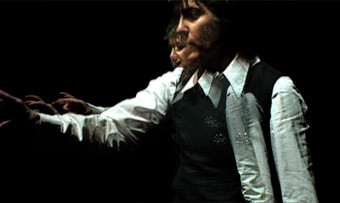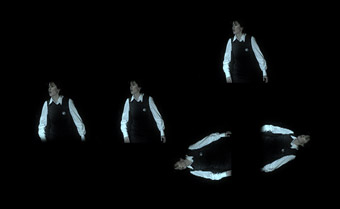 |
Rose Dennis, Anamorphic Archive, video still Sam James |
Dennis, clad in the uniform of an office worker—white blouse, blue vest, blue skirt, brown shoes—strides through a large space framed on one side by a black brick wall. The footage, including the audio track, is slowed down, Dennis’ footsteps on the dark floorboards echoing ominously as she walks forwards as well as back. There is something eerie about this opening sequence. Slowing down the footage gives the performer a menacing presence. Is this is the calm before the storm?
 |
Rose Dennis, Anamorphic Archive, video still Sam James |
Usually, the main objective of the archival documenting of live performance is to preserve the works, making them accessible to viewers long after the actual performance. With Anamorphic Archive, James subtly subverts this notion. His work begins where other archivists stop. He uses the documentary footage as source material for his own artistic endeavours. Taking the liberty to change the framing and timing of the documented live performance, James reinvents the original, creating a new, autonomous work in the process.
It is James’ great achievement that, even though he manipulates the documentary footage entirely according to his own artistic vision, he manages to capture the essence of the original works. This brings up the question: can Anamorphic Archive only be appreciated by those who have seen the live performances on which the films are based? The answer is inconclusive. The results of James’ digital treatment are so accomplished and sophisticated that the films certainly can be enjoyed as independent works in their own right. On the other hand, there is definitively an added joy in being able to see to what extent and effect James has altered the original performance.
The live version of Rosie Dennis’ Access All Areas, for example, is a model of conceptual rigour, choreographic economy and performance skill. At first glance, it is difficult to imagine how such a finely tuned work can possibly gain through digital manipulation. And yet, by creating images that exemplify the inner turmoil of Dennis’ troubled office worker, James succeeds in adding a dimension that cannot be achieved in live performance. One section in the film is particularly memorable in this respect: five images of Dennis are positioned in different places on the screen, all in sync. Dennis moves at the same breakneck speed as in the earlier section described above, but the sound has now been removed. With her gunfire vocals silenced, her franticness appears strangely softened. The images are then rotated at different angles, appearing to float freely against the black backdrop of the screen. It’s as if Dennis has lost her footing, drifting in space, alone, lost to herself and her viewers. Her head is still shaking, circled by one of her hands, desperately searching. Suddenly, the images of Dennis multiply again. Serialized in eight rows of 12 small images each, now there are almost a hundred incarnations of Dennis.
The title of Sam James’ dance film project refers to the phenomenon of anamorphosis, describing both a distorted image that appears normal when viewed from a particular point or with a special device and the process by which such images are produced. Creating new films by digitally distorting their documentary source material, James offers audiences a new perspective from which to view the original works. As is the case with his take on Rosie Dennis’ work, James does not abuse his role as the all powerful manipulator. He tries to stay true to the intentions of the dance makers. It is his interest to illuminate rather than to obscure. The sensitivity with which James approaches the manipulation process prevents his reinterpretations from competing with the originals. The films are distorted reflections of the live works, neither one more real than the other.
Sam James, Anamorphic Archive, DVD compilation, documentary footage of performances by Rosie Dennis, Julie-Anne Long, Jeff Stein, Martin del Amo, The Fondue Set, Lizzie Thomson, Tess de Quincey, Michelle Outram, post-production sound Gail Priest; Performance Space Residency Program, Carriage Works, Sydney, February-March 2008; http://www.shimmerpixel.blogspot.com/
© Martin del Amo; for permission to reproduce apply to [email protected]








 back
back